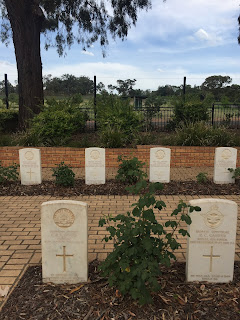Celebrating Christmas in summer heat is something we are just starting to recognize is actually going to happen. The weather is certainly becoming warmer with temperatures near 38 degrees Celsius tomorrow (100 Fahrenheit). The days are long and beautiful but that also means those blue-tongued lizards living under the bushes are going to be out a lot more. Don swept all the spider webs off the wrought iron pillars around our home yesterday. Literally, the webs are everywhere. Several people told us to have large walking sticks to knock down the webs as we are taking walks. We have learned that was good advice. As I walked into a web on a morning walk, I had several strands of silk stick to my sleeves and face. Fortunately, the spider that came with it was dead though my scream might have changed that circumstance. Even the car has spiders living in the driver-side mirror. We've sprayed it but that web reappears as if by magic. This is not boding well for me in the summer months ahead.
But we decided we could at least have a tiny tree for our only Christmas that we will spend here in Australia. I found a number of ornaments of indigenous animals to use as decorations: a kangaroo (of course!), a baby joey in a boot, a koala, a surfing platypus, a wombat, a cockatoo, a tazmanian devil (which were just reintroduced), a bilby, a fairy penguin, and an emu. A couple other birds and the distinctive red "ute" that Santa has been known to drive finishes off our tree. One other decoration is the koala Santa being pulled by one white "boomer."


We went back into the city yesterday and saw all the Merry Christmas Sydney banners lining most of the main thoroughfares. Several of these decorated trees were in strategic places. This one is in front of the Customs House which is now a museum and performance space. It is funny to us to see summer pajamas on sale next to the Christmas decor. I don't think even in the southern U.S. at this time of year I've ever seen so much beach wear with swimsuits, flip-flops (still referred to as thongs here) and all the other vestiges of summer ever present. This is going to be a fun year to experience a different kind of holiday season.
Like last week, we wandered through some other areas and found some more interesting sites and public art. The statue of this little boy stands as a reminder that even children seeking asylum are kept in detention as part of Australian government policy. The plaque said "Their suffering is our shame." Interesting that countries worldwide wrestle with similar issues and apparently do not have any better answers for those fleeing violence and persecution. A silent protest, the final sentence states, "Here at this site we remember them and together call out for change." I think of the many refugee families I knew and loved in Germany and feel my heart asking what can I do now to continue helping those in need?
This Pioneer Women's Memorial is to honor those women who helped in the colonization of the country. It was erected as part of the Bicentennial celebrations in 1988.
More sites on our wanderings by bus and on foot. Emus and kangaroos depicted on the George St. side of the old General Post Office Building.
King Edward VII, oldest son of Queen Victoria and Prince Albert, was nearly 60 before he was crowned king. This equestrian statue is to honor him and shows him in full military uniform. It's found outside the Conservatory of Music and by the Royal Botanic Gardens. WE got a quick glimpse of a fountain in the park as we went by on the bus.
Here is the Central Railway Station. Built as the third terminal station in Sydney, it has served the area since 1906. It was built over a cemetery; all the remains were reinterred at different cemeteries throughout the city.
Another interesting place to visit is the Central Park Mall at One Central Park. The foilage on the outside of the building are considered the tallest vertical gardens in the world as the flowers, vines and plants climb 50 metres all without soil. The nutrients and water are all dispersed mechanically. It has two towers with residential apartments and the shopping area is found on the first 6 floors.

















































